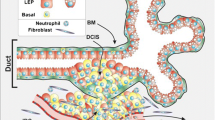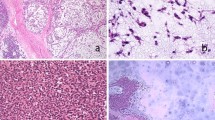Summary
Myoepithelial cells exert important paracrine effects on epithelial morphogenesis and mitogenesis through direct cell-cell interactions and through synthesis of a basement membrane extracellular matrix. To study these effects further, this study established the first immortalized human myoepithelial cell line, HMS-1, and transplantable xenograft, HMS-X, from the rare parotid basal cell adenocarcinoma. The cell line exhibited a fully differentiated myoepithelial phenotype and the xenograft exhibited the rare property of accumulating an abundant extracellular matrix composed of both basement membrane and nonbasement membrane components with the latter predominating. With HMS-1 as a feeder layer, dramatic and specific induction of epithelial morphogenesis (sheroid formation) occurred with selected normal epithelial and primary carcinoma target cells. HMS-1 and HMS-X provide distinct advantages over the conventional murine matrices in existence. They will be invaluable in future studies of human tumor-myoepithelial and matrix interactions important for tumor cell growth, invasion, and metastasis.
Similar content being viewed by others
References
Azuma, M.; Hayashi, Y.; Yoshida, H., et al. Emergence of differentiated subclones from a human salivary adenocarcinoma cell clone in culture after treatment with sodium butyrate. Cancer Res. 46:770–777; 1986.
Azuma, M.; Kawamata, H.; Kasai, Y., et al. Effects of retinoic acid on morphological features and biological markers of a neoplastic human salivary intercalated duct cell line in culture. Cancer Res. 48:7219–7225; 1988.
Azuma, M.; Sato, M. Morphogenesis of normal human salivary gland cellsin vitro. Histol. Histopathol. 9:781–790; 1994.
Azuma, M.; Tamatani, T.; Kasai, Y., et al. Immoralization of normal human salivary gland cells with duct-, myoepithelial-, acinar-, or squamous phenotype by transfection with SV40 Ori mutant deoxyribonucleic acid. Lab. Invest. 69:24–42; 1993.
Baldwin, C. T.; Reginato, A. M.; Smith, C., et al. Structure of cDNA clones coding for human type II procollagen: the α(II) chain is more similar to the α1(I) chain than two other fibrillar collagens. Biochem. J. 262:521–528; 1989.
Bao, L.; Matsumura, Y.; Baban, D., et al. Effects of inoculation site and Matrigel on growth and metastasis of human breast cancer cells. Br. J. Cancer 70:228–232; 1994.
Barsky, S. H.; Layfield, L.; Varki, N., et al. Two human tumors with high basement membrane-producing potential. Cancer 61:1798–1806; 1988.
Caselitz, J.; Schmitt, P.; Seifert, G., et al. Basal membrane associated substances in human salivary glands and salivary gland tumors. Pathol. Res. Pract. 183:386–394; 1988.
Chaudhry, A. P.; Leifert, C.; Cutler, L. S., et al. Histogenesis of adenoid cystic carcinoma of the salivary glands: light and electron microscopic study. Cancer 58:72–82; 1986.
Cheng, J.; Saku, T.; Okabe, H., et al. Basement membranes in adenoidcystic carcinoma: an immunohistochemical study. Cancer 69:2631–2640. 1992.
Dickson, S. R.; Warburton, M. J. Enhanced synthesis of gelatinase and stromelysin by myoepithelial cells during involution of the rat mammary gland. J. Histochem. Cytochem. 40:697–703; 1992.
Ellis, G. L.; Wiscovitch, J. G. Basal cell adenocarcinomas of the major salivary glands. Oral Surg. Oral Med. Oral Pathol. 69:461–469; 1990.
Emerman, J. T.; Vogl, A. W. Cell size and shape changes in the myoepithelium of the mammary gland during differentiation. Anat. Rec. 216:405–415; 1986.
Fridman, R.; Giaccione, G.; Kanemoto, T., et al. Reconstituted basement membrane (Matrigel) and laminin can enhance the tumorigenicity and the drug persistence of small cell lung cancer cell lines. Proc. Natl. Acad. Sci. USA 87:6698–6702; 1990.
Fridman, R.; Kibbey, M. C.; Royce, L. S., et al. Enhanced tumor growth of both primary and established human and murine tumor cells in athymic mice after coinjection with matrigel. J. Natl. Cancer. Inst. 83:769–774; 1991.
Gallimore, A. P.; Spraggs, P. D. R.; Allen, J. P., et al. Basaloid carcinomas of salivary glands. Histopathology 24:139–144; 1994.
Gallo, O.; Bani, D.; Toccafondi, G., et al. Characterization of novel cell line from pleomorphic adenoma of the parotid gland with myoepithelial phenotype and producing interleukin-6 as an autocrine growth factor. Cancer 70:559–568; 1992.
Giard, D. J.; Aaronson, S. A.; Todaro, G. J., et al. In vitro cultivation of human tumors: establishment of cell lines derived from a series of solid tumors. J. Natl. Cancer Inst. 51:1417–1423; 1973.
Guelstein, V. I.; Tchypsheva, T. A.; Ermilova, V. D., et al. Myoepithelial and basement membrane antigens in benign and malignant human breast tumors. Int. J. Cancer 53:269–277; 1993.
Hayashi, Y.; Yoshida, H.; Nagamine, S., et al. Induction of cells with acinar cell phenotype including presence of intracellular amylase: treatment with 12-O-tetradecanoyl-phorbol-13-acwtate in a neoplastic human salivary intercalated duct cell line grown in athymic nude mice. Cancer 60:1000–1008; 1987.
Hayat, M. A. Principles and techniques of electron microscopy: biological applications, 3rd ed. Boca Raton, FL: CRC Press; 1989:137.
Hedley, D. W.; Friedlander, M. L.; Taylor, I. W., et al. Method for analysis of cellular DNA content in paraffin-embedded pathological material using flow cytometry. J. Histochem. Cytochem. 31:1333–1335; 1983.
Jeffreys, A. J.; Wilson, V.; Thein, S. L., et al. Hypervariable “minisatellite” regions in human DNA. Nature 314:67–73; 1985.
Kibbey, M. C.; Grant, D. S.; Kleinman, H. K. Role of the SIKVAV site of laminin in promotion of angiogenesis and tumor growth: an in vivo matrigel model. J. Natl. Cancer Inst. 84:1633–1638; 1992.
Kibbey, M. C.; Royce, L. S.; Dym, M., et al. Glandular-like morphogenesis of the human submandibular tumor cell line A253 on basement membrane components. Exp. Cell Res. 198:343–351; 1992.
Kleinman, H. K.; McGarvey, M. L.; Hassell, J. R., et al. Basement membrane complexes with biological activity. Biochemistry 25:312–318; 1986.
Kleinman, H. K.; McGarvey, M. L.; Liotta, L. A., et al. Isolation and characterization of type IV procollagen, laminin, and heparan sulfate proteoglycan from the EHS sarcoma. Biochemistry 21:6188–6193; 1982.
Kondo, T.; Muragishi, H.; Imaizumi, M. A cell line from human salivary gland mixed tumor. Cancer 27:403–410; 1971.
Laemmli, U. K. Cleavage of structural protein during the assembly of the head of bacteriophage T4. Nature 227:680–685; 1970.
Liotta, L. A.; Rao, C. N.; Barsky, S. H. Tumor invasion and the extracellular matrix. Lab. Invest. 49:636–649; 1983.
Mann, K.; Deutzmann, R.; Paulsson, M., et al. Solubilization of a protein BM-40 from a basement membrane tumor with chelating agents and evidence for its identity with osteonectin and SPARC. FEBS Lett. 218:167–172; 1987.
Martinez-Hernandez, A.; Amenta, P. S. The basement membrane in pathology. Lab. Invest. 48:656–677; 1983.
Murdoch, A. D.; Dodge, G. R.; Cohen, I., et al. Primary structure of the human heparan sulfate proteoglycan from basement membrane (HSPG2/perlecan). J. Biol. Chem. 267:8544–8557; 1992.
Nakamura, Y.; Leppert, M.; O'Connell, P., et al. Variable number of tandem repeat (VNTR) markers for human gene mapping. Science 235:1616–1622; 1987.
Nakanishi, K.; Kawai, T.; Suzuki, M., et al. Glycosaminoglycans in pleomorphic adenoma and adenoid cystic carcinoma of the salivary gland. Arch. Pathol. Lab. Med. 114:1227–1231; 1990.
Nara, Y.; Takeuchi, J.; Yoshida, K., et al. Immunohistochemical characterization of extracellular matrix components of salivary gland tumors. Br. J. Cancer 64:307–314; 1991.
Noel, A. C.; Calle, A.; Emonard, H. P., et al. Invasion of reconstituted basement membrane matrix is not correlated to the malignant metastatic phenotype. Cancer Res. 51:405–415; 1991.
Ormos, J.; Halasz, A. Electron microscopic study of adenoid cystic carcinoma. Ultrastruct Pathol. 15:149–157; 1991.
Pan, T. C.; Kluge, M.; Zhang, R. Z., et al. Sequence of extracellular mouse protein BM-90/fibulin and its calcium-dependent binding to other basement-membrane ligands. Eur. J. Biochem. 215:733–740; 1993.
Passaniti, A.; Isaacs, J. T.; Haney, J. A., et al. Stimulation of human prostatic carcinoma tumor growth in athymic mice and control of migration in culture by extracellular matrix. Int. J. Cancer 51:318–324; 1992.
Robinson, L. K.; Murrah, V. A.; Moyer, M. P., et al. Characterization of a novel glycoprotein isolated from the basement membrane matrix of the Engelbreth-Holm-Swarm tumor. J. Biol. Chem. 264:5141–5147; 1989.
Royce, L. S.; Kibbey, M. C.; Mertz, P., et al. Human neoplastic submandibular intercalated duct cells express an acinar phenotype when cultured on a basement membrane matrix. Differentiation 52:247–255; 1993.
Sambrook, J.; Fritsch, E. F.; Maniatis, T. Molecular cloning: a laboratory manual, 2nd ed. Cold Spring Harbor, NY: Cold Spring Harbor Laboratory Press; 1989.
Sato, M.; Azuma, M.; Hayashi, Y., et al. 5-Azacytidine induction of stable myoepithelial and acinar cells from a human salivary intercalated duct cell clone. Cancer Res. 47:4453–4459; 1987.
Shirasuna, K.; Morioka, S.; Watatani, K., et al. Growth inhibition and differentiation of human salivary adenocarcinoma cells by medium conditioned with normal human fibroblasts. Cancer Res. 48:2819–284; 1988.
Shirasuna, K.; Sato, M.; Miyazaki, T. A myoepithelial cell line established from a human pleomorphic adenoma arising in minor salivary gland. Cancer 45:297–305; 1980.
Shirasuna, K.; Sato, M.; Miyazaki, T. A neoplastic epithelial duct cell line established from an irradiated human salivary gland. Cancer 48:745–752; 1981.
Shirasuna, K.; Watatani, K.; Furusawa, H., et al. Biological characterization of pseudocyst-forming cell lines from human adenoid cystic carcinomas of minor salivary gland origin. Cancer Res. 50:4139–4145; 1990.
Shirasuna, K.; Watanani, K.; Sugiyama, M., et al. Isolation and characterization of different clones including myoepithelial-like variants from a clonal neoplastic epithelial duct cell line of human salivary gland origin. Cancer Res. 46; 1418–1426; 1986.
Skalova, A.; Leivo, I. Basement membrane proteins in salivary gland tumours: distribution of type IV collagen and laminin. Virchows Archiv. A Pathol. Anat. Histopathol. 420:425–431; 1992.
Sobue, M.; Takeuchi, J.; Niwa, M., et al. Establishment of a cell line producing basement membrane components from an adenoid cystic carcinoma of the human salivary gland. Virchows Archiv. B Cell. Pathol. 57:203–208; 1989.
Soini, Y.; Autio-Harmainen, H. Synthesis and degradation of basement membranes in benign and malignant salivary gland tumors. A study byin situ hybridization. J. Pathol. 170:291–296; 1993.
Toth, J.; Sugar, J.; Csuka, O. The role of myoepithelial cells in the morphogenesis of induced mammary tumors. Virchows Arch. A Pathol. Anat. Histol. 385:41–48; 1979.
Tsubura, A.; Shikata, N.; Inui, T., et al. Immunohistochemical localization of myoepithelial cells and basement membrane in normal, benign and malignant human breast lesions. Virchows Arch. A Pathol. Anat. Histopathol. 413:133–139; 1988.
Vukicevic, S.; Kleinman, H. K.; Luyten, F. P., et al. Identification of multiple active growth factors in basement membrane Matrigel suggests caution in interpretation of cellular activity related to extracellular matrix components. Exp. Cell Res. 202:1–8; 1992.
Witsell, D. L.; Weissler, M. C.; Livanos, E., et al. Unique chromosomal rearrangement and mucin production in a novel salivary myoepithelial cell strain. Arch. Otolaryngol. Head Neck Surg. 119:1151–1157; 1993.
Yoshida, H.; Azuma, M.; Yanagawa, T., et al. Effect of dibutyryl cyclic AMP on morphologic features and biologic markers of a human salivary gland adenocarcinoma cell line in culture. Cancer 57:1011–1018; 1986.
Yoshida, M.; Uchibori, N.; Sato, E., et al. A cell line from a human salivary gland carcinoma. Br. J. Cancer 41:636–639; 1980.
Author information
Authors and Affiliations
Rights and permissions
About this article
Cite this article
Sternlicht, M.D., Safarians, S., Calcaterra, T.C. et al. Establishment and characterization of a novel human myoepithelial cell line and matrix-producing xenograft from a parotid basal cell adenocarcinoma. In Vitro Cell.Dev.Biol.-Animal 32, 550–563 (1996). https://doi.org/10.1007/BF02722982
Received:
Accepted:
Issue Date:
DOI: https://doi.org/10.1007/BF02722982




